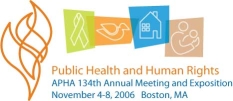 Back to Annual Meeting
|

|
 Back to Annual Meeting
|
APHA Scientific Session and Event Listing |
 Back to Annual Meeting
|

|
 Back to Annual Meeting
|
APHA Scientific Session and Event Listing |
Eric S. Pevzner, PhD, MPH1, Susan Robison, PHN2, Donna Allis, PhD, RN2, Hollianne Bruce, MPH3, Rachel Friedman, BS1, Christopher Spitters, MD, MPH2, Ward Hinds, MD, MPH2, Kashef Ijaz, MD, MPH1, John Oeltmann, PhD, MSPH2, and David Peterson, RS, MPA3. (1) Division of Tuberculosis Elimination, Centers for Disease Control and Prevention, 1600 Clifton Road, Mailstop E-10, Atlanta, GA 30333, 404-639-6094, ecp9@cdc.gov, (2) Communicable Disease Division/Tuberculosis Control Program, Snohomish Health District, 3020 Rucker Ave, Everett, WA 98201-3900, (3) Communicable Disease Division, 3020 Rucker Ave, Everett, WA 98201-3900
Background: Congregation of illicit drug users (i.e., cocaine, heroin, marijuana) has led to past tuberculosis outbreaks. While estimates suggest that 12.3 million Americans have used methamphetamines, the relationship between methamphetamine use and TB is not documented or well understood. In 2006, the Snohomish Health District in Washington State reported a cluster of tuberculosis cases among methamphetamine users. We investigated to determine the role methamphetamine use played in the transmission of Mycobacterium tuberculosis.
Methods: We included TB patients diagnosed from January 2005–February 2006 having matching genotypes to the index case or epidemiological links to patients already included. We reviewed medical records and interviewed case patients, their contacts, and nurses. Information about methamphetamine use was either self-reported or gathered through key informants.
Results: Nine patients met the inclusion criteria. All were epidemiologically linked and reported methamphetamine use. Their median age was 35 years (range: 19–54). The patients reported 119 contacts, 73 of whom had a tuberculin skin test (TST); 28 (38%) of 73 had a positive TST result. More than 40% of adult contacts used methamphetamines. Among contacts using methamphetamines, 14 (64%) of 22 had a positive TST result compared with three (25%) of 12 not using methamphetamines.
Discussion: Methamphetamine use was widespread among these patients and contacts. Elevated prevalence of positive TST results among methamphetamine users suggests that it contributed to transmission of M. tuberculosis. Addressing TB in this population requires TB control and substance abuse programs to collaboratively identify cases and contacts and promote treatment adherence.
Learning Objectives:
Keywords: TB,
Presenting author's disclosure statement:
Any relevant financial relationships? No
The 134th Annual Meeting & Exposition (November 4-8, 2006) of APHA